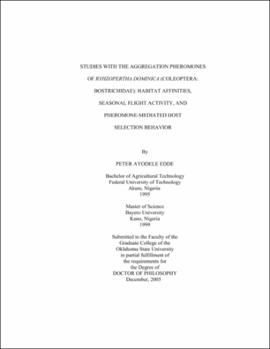| dc.contributor.advisor | Phillips, Thomas W. | |
| dc.contributor.author | Edde, Peter Ayodele | |
| dc.date.accessioned | 2013-11-26T08:23:44Z | |
| dc.date.available | 2013-11-26T08:23:44Z | |
| dc.date.issued | 2005-12 | |
| dc.identifier.uri | https://hdl.handle.net/11244/6733 | |
| dc.description.abstract | Scope and Method of Study: Two approaches were adopted in these studies. The first part of the dissertation investigated seasonal abundance and flight activity patterns of R. dominica in different habitats in central Oklahoma using synthetic pheromones. The second part of the study investigated host effects on reproductive success, pheromone production and host finding by R. dominica. | |
| dc.description.abstract | Findings and Conclusions: R. dominica populations were greater near grain storage facilities than in forests or in open fields, indicating the relative ability of these habitats to sustain these beetles. Captured R. dominica in pheromone-baited traps were female-biased, and the proportion of females to males did not differ among habitats in which the beetles were trapped. Seasonal flight activity patterns of R. dominica were similar between grain elevator and forest habitats; however, in two of the three years of trapping, flight activity generally began at least 1-2 weeks earlier in forest sites as opposed to grain elevators. Weekly weather variables at grain storage elevators and forest sites, respectively explained about 80 and 86% of the variability in R. dominica trap captures. Behavioral responses of adult R. dominica showed that both sexes were able to respond to plant volatiles at short range (walking bioassay), and the attraction was strongest to plant species most suitable for beetle development. However, plant volatiles alone failed to attract dispersing R. dominica under field conditions. In contrast, beetles responded strongly to traps baited with male-infested plant materials, indicating that the male-produced aggregation pheromones may be the most important stimuli for host finding and subsequent aggregation in R. dominica. Regression analyses showed no correlation between beetle size and pheromone output in R. dominica. Host plant, rather than beetle body size, significantly affects pheromone release. More pheromones were released by adults feeding on plant parts such as cereal grains compared to non-cereal grains or woody tissues. | |
| dc.format | application/pdf | |
| dc.language | en_US | |
| dc.rights | Copyright is held by the author who has granted the Oklahoma State University Library the non-exclusive right to share this material in its institutional repository. Contact Digital Library Services at lib-dls@okstate.edu or 405-744-9161 for the permission policy on the use, reproduction or distribution of this material. | |
| dc.title | Studies with the aggregation pheromones of Rhyzopertha dominica (Coleoptera: Bostrichidae): Habitat affinities, seasonal flight activity, and pheromone-mediated host selection behavior | |
| dc.contributor.committeeMember | Dillwith, Jack W. | |
| dc.contributor.committeeMember | Payton, Mark E. | |
| dc.contributor.committeeMember | Mulder, Phillip G., Jr. | |
| osu.filename | Edde_okstate_0664D_1558.pdf | |
| osu.accesstype | Open Access | |
| dc.type.genre | Dissertation | |
| dc.type.material | Text | |
| thesis.degree.discipline | Entomology | |
| thesis.degree.grantor | Oklahoma State University | |
